Affordable travel in the Czech Republic |
Outside Prague |
| • Kutná Hora |
| • Litomyšl |
| • Olomouc |
| • Český Krumlov |
| • Karlovy Vary |
| • Mělník |
| • Kutná Hora |
| • Karlštejn castle |
| • Terezín |
| • Lidice |
| • Adršpach Rocks |
| • Bohemian Paradise |
| • České Budějovice |
| • Český Ráj |
| • Hradec Králové |
| • Liberec |
| • Plzeň |
| • Telč |
| Mikulov |
| Ostrava |
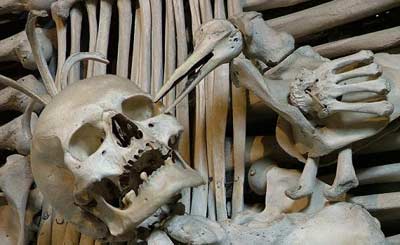
Kutná Hora Kutná Hora. You’ve no doubt heard of it already because of the famous ‘bone church’ that lures hundreds of travellers on daytrips outside Prague. If you’re only planning to visit the bone church, you’re doing yourself a great injustice, because you’re almost at the doorstep of the country’s most spectacular cathedral, underground tours exploring a fascinating history of silver mining, and a clutch of great little bars and restaurants serving fresh beer and traditional food for half the price you paid in Prague. Crazy Monks
Urban myth says that a monk went mad and made sculptures from the bones, but the present appearance is the work of a woodcarver named František Rint who was commissioned in 1870 to decorate the chapel. His fantastic creations include a coat of arms of the local aristocratic Schwarzenberg family and a chandelier that contains every bone in the human body. There are a few other bone churches scattered around Central Europe, but none are nearly as fascinating or photogenic. Medieval skyscrapers
Lazy Monks Kutná Hora’s wealth and renown were built on mining. Legend has it that when a lazy monk named Anton woke up from a nap in the monastery orchard, he discovered three pieces of silver protruding from the ground near his face, and laid down his robe (‘Kutna’, in Czech) to mark the place. When the monks investigated further they found that the three pieces of silver were the tip of the iceberg and Kutná Hora’s days as the richest silver mine in the Kingdom of Bohemia began. As the Bohemians’ greatest source of wealth, Kutná Hora received plenty of attention. Palaces were built, the city was fortified, the royal mint was relocated here and Kings Vaclav IV and Vladislav Jagellonsky are among those who preferred Kutná Hora to Prague. Bohemian Gothic
The separate museum of silver mining is nearby and offers tours deep into the dark underbelly of Kutná Hora. You get your own coat and headlamp for the tour, which takes you six stories below ground, over an underground river and out onto the hillside below the old city fortifications. Too much for one day
Which is fortunate because there’s far too much in Kutná Hora to cover in a single day.
|
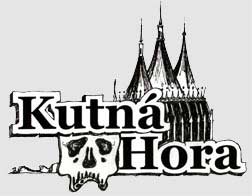 |
See and Do |
| • Kutná Hora Overview |
| • Daytrip to Kutná Hora from Prague |
| • Bone Church |
| • St. Barbara's cathedral |
| • The Silver Mines |
| • The Royal Mint |
| • The Streets and Squares |
Eat, Drink and Sleep |
| • Dačický beerhall |
| • Restaurant V Ruthardce |
| • Hotel/Pension U Kata |
| • Check Kutná Hora Hotel Rooms |
| • Check availability of Prague Rooms |
| Getting there |
| • Getting to Kutná Hora |
| • Kutná Hora Daytrip map to print |
• Home •Blog• About• Contact• Sitemap •Links•
Outside Prague last updated June 13th, 2010. All text and images Copyright 2007-2010. Articles may be excerpted for review, or printed for use by individual travellers.
Complete articles or images may not otherwise be reproduced by print, electronic or other means.
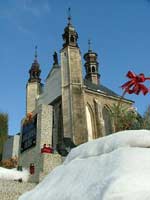 The proper name of the ‘bone church’ is the Chapel of All Saints (kaple všech svatých). When a handful of earth from the holy-land was sprinkled over the surrounding graveyard, the chapel shot to stardom as the hippest resting place for the rich and famous. As war and plague came and went the new burials outgrew the space available, and the older bones were removed and stored in the crypt of the chapel.
The proper name of the ‘bone church’ is the Chapel of All Saints (kaple všech svatých). When a handful of earth from the holy-land was sprinkled over the surrounding graveyard, the chapel shot to stardom as the hippest resting place for the rich and famous. As war and plague came and went the new burials outgrew the space available, and the older bones were removed and stored in the crypt of the chapel. 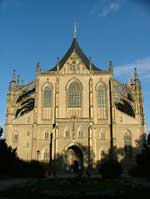 The Czech Republic is a land of, among other things, spectacular gothic cathedrals, and the one in Kutná Hora is the most spectacular of them all. With its three tent-like spires soaring skywards from the highest cliff above the river Vrchlice, it’s visible for miles around and leaves very, very few visitors unimpressed. Dedicated to St Barbora, patron saint of miners, the cathedral is an integral part of Kutná Hora’s history and the main monument that helped Kutná Hora onto the UNESCO world heritage list.
The Czech Republic is a land of, among other things, spectacular gothic cathedrals, and the one in Kutná Hora is the most spectacular of them all. With its three tent-like spires soaring skywards from the highest cliff above the river Vrchlice, it’s visible for miles around and leaves very, very few visitors unimpressed. Dedicated to St Barbora, patron saint of miners, the cathedral is an integral part of Kutná Hora’s history and the main monument that helped Kutná Hora onto the UNESCO world heritage list.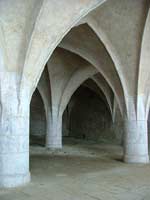 Other architectural gems remaining from Kutná Hora’s glory days include the pragmatically named Stone house and Stone fountain, the Corpus Christi chapel, and the small fortified castle; Hradek, which became the mint and is now an excellent museum showcasing minting techniques, coins, and the history of the Prague Groschen in particular.
Other architectural gems remaining from Kutná Hora’s glory days include the pragmatically named Stone house and Stone fountain, the Corpus Christi chapel, and the small fortified castle; Hradek, which became the mint and is now an excellent museum showcasing minting techniques, coins, and the history of the Prague Groschen in particular. 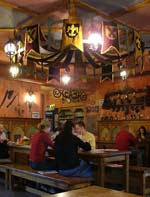 The bone chapel, cathedral, and mine tour are the highlights of Kutná Hora, but there’re other impressive churches, lovely back streets and lanes to wander around and Europe’s only Museum of Alchemy. The meals at V Ruthardce and the beer at the Dacicky beerhall are some of the best you’ll find in Bohemia and there are some good inexpensive places to stay too.
The bone chapel, cathedral, and mine tour are the highlights of Kutná Hora, but there’re other impressive churches, lovely back streets and lanes to wander around and Europe’s only Museum of Alchemy. The meals at V Ruthardce and the beer at the Dacicky beerhall are some of the best you’ll find in Bohemia and there are some good inexpensive places to stay too.